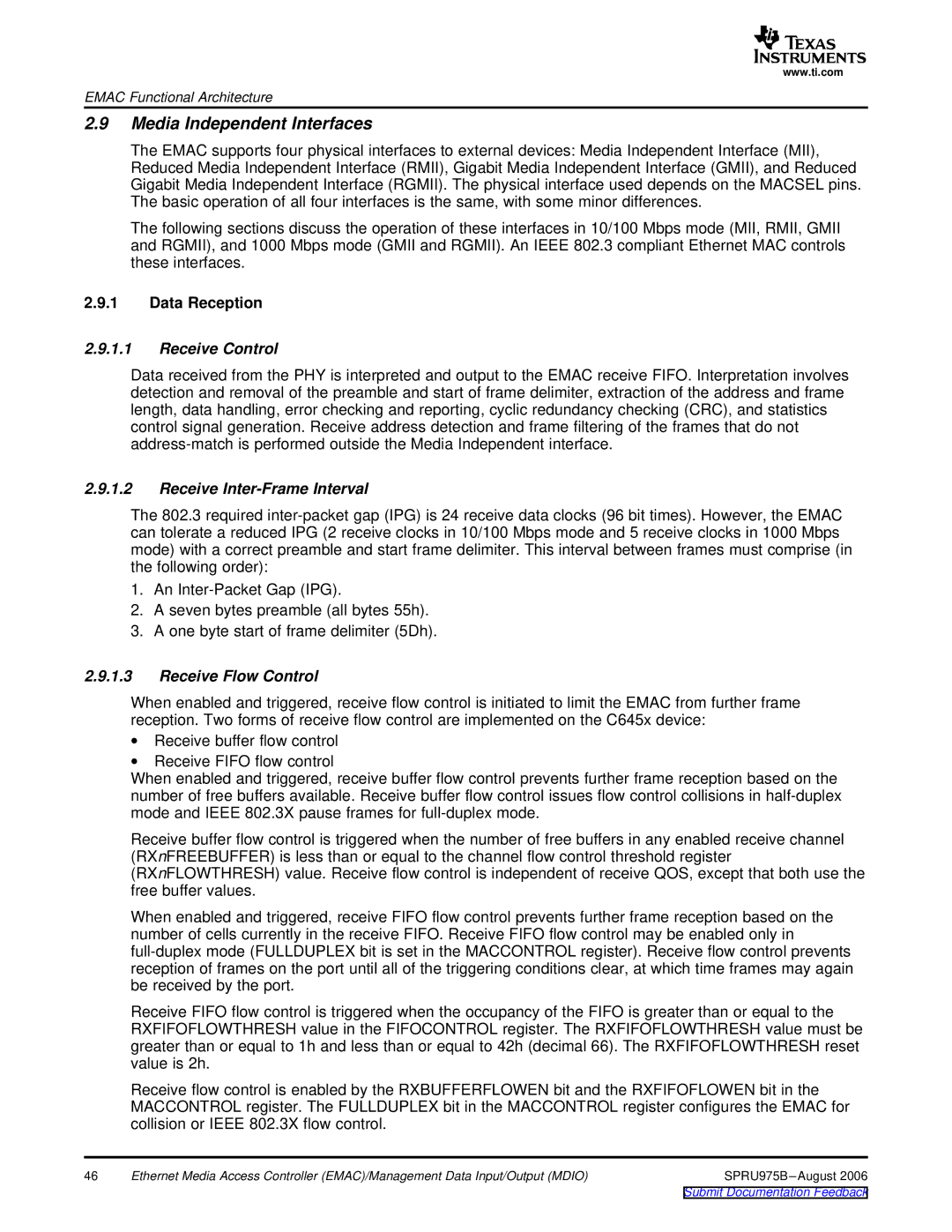
www.ti.com
EMAC Functional Architecture
2.9Media Independent Interfaces
The EMAC supports four physical interfaces to external devices: Media Independent Interface (MII), Reduced Media Independent Interface (RMII), Gigabit Media Independent Interface (GMII), and Reduced Gigabit Media Independent Interface (RGMII). The physical interface used depends on the MACSEL pins. The basic operation of all four interfaces is the same, with some minor differences.
The following sections discuss the operation of these interfaces in 10/100 Mbps mode (MII, RMII, GMII and RGMII), and 1000 Mbps mode (GMII and RGMII). An IEEE 802.3 compliant Ethernet MAC controls these interfaces.
2.9.1Data Reception
2.9.1.1Receive Control
Data received from the PHY is interpreted and output to the EMAC receive FIFO. Interpretation involves detection and removal of the preamble and start of frame delimiter, extraction of the address and frame length, data handling, error checking and reporting, cyclic redundancy checking (CRC), and statistics control signal generation. Receive address detection and frame filtering of the frames that do not
2.9.1.2Receive Inter-Frame Interval
The 802.3 required
1.An
2.A seven bytes preamble (all bytes 55h).
3.A one byte start of frame delimiter (5Dh).
2.9.1.3Receive Flow Control
When enabled and triggered, receive flow control is initiated to limit the EMAC from further frame reception. Two forms of receive flow control are implemented on the C645x device:
∙Receive buffer flow control
∙Receive FIFO flow control
When enabled and triggered, receive buffer flow control prevents further frame reception based on the number of free buffers available. Receive buffer flow control issues flow control collisions in
Receive buffer flow control is triggered when the number of free buffers in any enabled receive channel (RXnFREEBUFFER) is less than or equal to the channel flow control threshold register (RXnFLOWTHRESH) value. Receive flow control is independent of receive QOS, except that both use the free buffer values.
When enabled and triggered, receive FIFO flow control prevents further frame reception based on the number of cells currently in the receive FIFO. Receive FIFO flow control may be enabled only in
Receive FIFO flow control is triggered when the occupancy of the FIFO is greater than or equal to the RXFIFOFLOWTHRESH value in the FIFOCONTROL register. The RXFIFOFLOWTHRESH value must be greater than or equal to 1h and less than or equal to 42h (decimal 66). The RXFIFOFLOWTHRESH reset value is 2h.
Receive flow control is enabled by the RXBUFFERFLOWEN bit and the RXFIFOFLOWEN bit in the MACCONTROL register. The FULLDUPLEX bit in the MACCONTROL register configures the EMAC for collision or IEEE 802.3X flow control.
46 | Ethernet Media Access Controller (EMAC)/Management Data Input/Output (MDIO) | SPRU975B |
